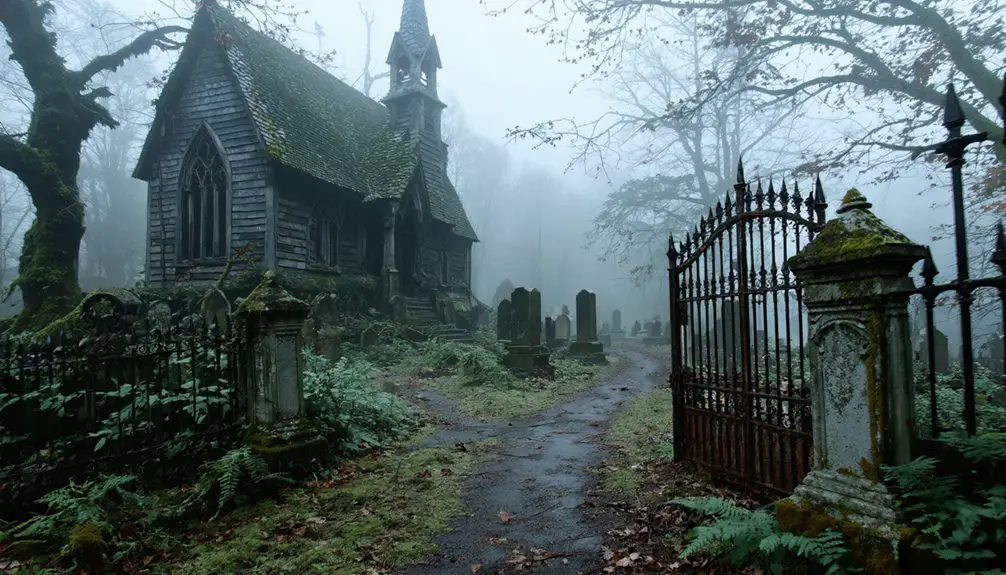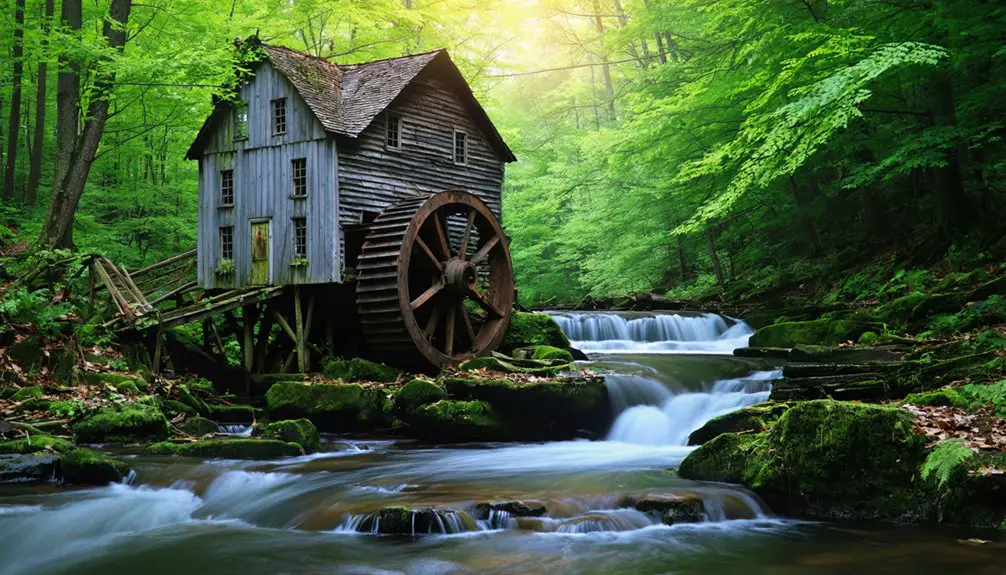You’ll find Green River’s ghost town nestled in Vermont’s Green Mountains, where a thriving lumber community once flourished in the 1800s. After reaching its peak population of 241 in 1880, the settlement faced devastating floods in 1898 and 1934 that destroyed essential infrastructure and forced families to abandon their homes. Today, you can explore the scattered remnants of this forgotten logging town, where Native American legends and mysterious disappearances add to its haunting allure.
Key Takeaways
- Green River was established in 1773 with Felix Powell’s log house and flourished during the lumber era before declining due to resource depletion.
- The devastating flood of 1898 destroyed crucial infrastructure and forced many families to abandon their homes, accelerating the town’s decline.
- Population peaked at 241 residents in 1880 but dwindled as logging resources were depleted and natural disasters struck the area.
- The town’s infrastructure deteriorated after railroad challenges, floods, and the bankruptcy of Vermont Central Railroad in 1896.
- Remnants of Green River’s logging past can still be found throughout the Green Mountain area, including old foundations and railroad ruins.
The Rise and Fall of a Mountain Settlement
While the Green Mountains formed millions of years ago through tectonic collisions and glacial carving, human settlement in the Green River area didn’t begin until 1773, when Felix Powell established his log house on Apple Tree Point.
The Abenaki people’s earlier presence in nearby valleys adds depth to the area’s rich settlement patterns. Archaeological discoveries show that Native hunting parties ventured into these mountains seeking big game. Though initially promising due to its natural resources and modest trade connections, Green River’s isolation and harsh mountain conditions eventually led to its decline as residents sought opportunities in more accessible locations.
You’ll find that Green River’s cultural heritage reflects the broader patterns of Vermont’s mountain communities, emerging during a time of territorial disputes between New Hampshire and New York. The settlement’s strategic location near Lake Champlain made it part of the region’s complex political landscape, where the Green Mountain Boys protected settlers’ land claims. The local settlers frequently gathered at the Catamount Tavern in nearby Bennington to discuss territorial matters.
Life in the Lumber Era
As Vermont’s frontier settlements expanded in the mid-1800s, logging emerged as the region’s economic powerhouse, surpassing agriculture and reshaping Green River’s landscape.
You’d find lumber workers rising before dawn, wielding axes and crosscut saws in a grueling daily battle against towering trees. Their logging traditions emphasized endurance and resourcefulness in Vermont’s rugged terrain. Early water-powered mills helped process the timber for transport downstream.
Life centered around seasonal logging camps, where you’d see teams of oxen and horses hauling massive logs to nearby rivers and mills. The area later became part of what is now the Green River Reservoir, constructed in 1917 for power production.
Before railroads arrived around 1850, you’d watch timber floating downstream to Burlington’s bustling port.
The industry transformed Green River into a working community, where crafting window sashes and blinds became common trade.
Yet this prosperity came at a cost – the land’s precious softwoods vanished, leaving only less valuable hardwoods in their wake.
Natural Disasters and Economic Collapse
You’ll find Green River’s darkest chapter emerged during the devastating flood of 1898, when raging waters destroyed the crucial railroad bridge and severed the town’s commercial lifeline.
The catastrophic loss of rail infrastructure coincided with the region’s depleting timber resources, dealing a crushing blow to the lumber-based economy. Like many areas across Vermont that would face similar challenges, the town demonstrated how severe flooding events could permanently alter a community’s trajectory. The scale of destruction mirrored what would later occur in the infamous 1927 flood, when rivers rose 13 feet above normal levels across the state.
What remained was a crippled town unable to sustain its population, as both natural and economic forces conspired to seal its fate as a future ghost town.
Devastating 1898 Flood Impact
During the summer of 1898, a catastrophic flood devastated the Green River region when torrential rains dumped 6 to 9 inches of water in just six hours. The raging waters overwhelmed dams and waterways, releasing destructive force on the town’s essential infrastructure. Two local dams powered the business district before the waters claimed them. The nearby Passumpsic River would later host hydroelectric facilities, showing the area’s enduring connection to water power.
You would’ve witnessed buildings swept off foundations, grist mills destroyed, and wagon shops displaced by the rushing currents.
The flood’s economic impact crippled local trades, with water-powered businesses ground to a halt. While community resilience showed through immediate flood recovery efforts like clearing debris and salvaging fish, the disaster left lasting scars.
The torrent reshaped the landscape, eroding farmland and altering creek paths. Though remarkably no deaths were reported, this event marked a turning point in Green River’s decline as displaced residents faced rebuilding their shattered livelihoods.
Railroad Infrastructure Destruction
While the 1898 flood dealt a severe blow to Green River, the town’s railroad infrastructure faced decades of compounding challenges from both economic pressures and nature’s fury.
You’ll find the story of railway failures written in the winding tracks through treacherous mountain passes, where landslides and river washouts constantly threatened service along the Dog River.
Infrastructure neglect became inevitable as the Vermont Central Railroad’s bankruptcy in 1896 and the Rutland Railway’s labor strikes in the 1950s and ’60s crippled operations. The struggling railway entered subsequent receivership in 1927.
The Central Vermont Railway continued operating through northern and central Vermont until its sale to New England Central Railroad in 1995.
The challenging terrain around Green River made repairs costly and slow, while harsh winters wreaked havoc on aging equipment.
Poorly planned routes through steep, unstable territory sealed the fate of these rail lines, leaving them vulnerable to both economic downturns and nature’s wrath.
Resource Depletion Crisis
The rapid deforestation around Green River marked the beginning of its inevitable decline.
You’ll find that intensive logging operations and charcoal production quickly stripped the surrounding forests, creating severe resource scarcity that crippled the town’s economic foundation.
The environmental impact proved catastrophic.
When major floods struck in 1898 and 1934, the weakened landscape couldn’t protect the settlement. The disasters destroyed infrastructure and forced remaining families to abandon their homes. Without trees to stabilize the soil, erosion accelerated, making the land increasingly unsuitable for agriculture or rebuilding.
You can trace Green River’s downfall directly to this resource exhaustion – as timber vanished, so did the jobs.
The town’s population plummeted from its peak of 241 in 1880, leading to closed businesses and a community that couldn’t sustain itself.
Mysterious Vanishings in the Woods

Deep within Vermont’s Glastenbury Woods, a series of chilling disappearances in the 1940s and 1950s haunted locals and sparked enduring mysteries.
The most notable cases involved Middie Rivers, an experienced hunting guide who vanished during a deer hunt in 1945, and Paula Welden, a Bennington College student who disappeared while hiking the Long Trail in 1946. Despite extensive search efforts, neither was ever found.
The dense forest’s challenging terrain and unpredictable weather conditions fueled various disappearance theories.
You’ll find the area’s remote, mountainous landscape created perfect conditions for disorientation, while frequent winds and poor visibility hampered rescue attempts.
These unsolved cases ultimately led to the creation of the Vermont State Police, though the woods still hold their secrets tight.
Native American Legends and Supernatural Tales
If you’ve hiked the ancient paths around Green River, you’ll find sacred sites where the Abenaki people once conducted healing rituals at the springs they called “medicine waters of the great spirit.”
You’ll notice that Brunswick Springs remains particularly significant, where an Abenaki sorceress allegedly cursed those who’d exploit the sacred waters for profit.
The surrounding mountains, including “Tawapodiiwajo” or “place to sit in mountain,” hold deep spiritual significance in Native American cosmology, with reported encounters of supernatural beings like the feared “gougou” continuing to this day.
Sacred Mountain Beliefs
Sacred mountains have long served as powerful spiritual gateways for Native American tribes across Vermont’s landscape. You’ll find these peaks marking territorial boundaries while protecting communities from illness and external threats.
The Abenaki people recognized mountains like Stratton, known as Tawapodiiwajo (“place to sit in mountain”), as essential connections between earth and spirit dimensions.
When you venture above the tree line, you’re entering spaces where indigenous people believed they could commune with thunder beings and the Creator.
At Mount Abraham, Tibetan Buddhists later identified sacred mandala formations, confirming what Native Americans had long known – these peaks hold concentrated spiritual power.
These mountains continue to serve as gathering places where communities share ancestral knowledge, conduct ceremonies, and maintain their cultural identity through traditional names and stories.
Unexplained Encounters
Throughout the rugged Vermont landscape, Native American tribes like the Abenaki passed down haunting tales of supernatural encounters near the Green River area’s waters and peaks.
You’ll find their warnings of a malevolent stone in the mountains that could devour travelers, and stories of ghost sightings around Silver Lake’s supposedly bottomless waters.
Near the Connecticut River, unexplained phenomena have persisted for generations, with both healing springs and dark forces marking sacred sites you’d be wise to avoid after sunset.
Local legends tell of the fearsome lake serpent “Memphre” lurking beneath Memphremagog’s surface, with over 200 reported sightings dating back to 1847.
The Bennington Triangle’s mysterious disappearances echo these ancient Native warnings about venturing too deep into this spiritually charged wilderness.
Exploring the Abandoned Wilderness Today
While Glastenbury’s days as a bustling logging town are long gone, you’ll find its ghostly remnants scattered throughout the dense Green Mountain wilderness.
If you’re seeking adventure along abandoned trails, be prepared for challenging terrain and unpredictable weather conditions – the area’s notorious winds can quickly disorient even experienced hikers.
You’ll discover traces of the town’s past as you navigate the rugged landscape, from old foundations to remnants of the logging railroad that once served this remote outpost.
The wilderness exploration requires caution, though, as the dense forests and steep mountain paths demand respect.
Hikers must approach Glastenbury’s untamed terrain with reverence, as its challenging wilderness leaves little room for careless steps.
For the independent spirit, Glastenbury’s untamed backcountry offers a raw, authentic glimpse into Vermont’s forgotten history, but you’ll need solid outdoor skills to explore this mysterious ghost town safely.
Frequently Asked Questions
What Happened to the Original Town Records After Disincorporation?
You’ll find the town archives were transferred to higher administrative bodies, with most records likely held by state or county repositories following standard historical preservation practices for disincorporated municipalities.
Were There Any Documented Murders or Crimes Before the Mysterious Disappearances?
Like pieces of a scattered puzzle, you’ll find the McCaffrey ax murders stand as the area’s main documented historical crime, though unsolved mysteries from neighboring towns reveal sporadic violent incidents before the disappearances.
How Many Original Buildings From Glastenbury Still Exist Today?
You won’t find any complete original Glastenbury buildings standing today. While hiking the trails, you’ll only discover scattered ruins, foundations, and cellar holes where the historical structures once existed.
Did Any Families Who Left During Abandonment Ever Return?
A million tales circulate, but you won’t find evidence of any permanent family returns after abandonment. While ghost sightings draw occasional visitors, records show families never resettled these haunted mountains again.
What Wild Animals Were Commonly Encountered by Early Settlers?
You’d encounter abundant white-tailed deer, black bears, and moose during settler experiences, while beavers, mink, and otters frequented waterways. Loons, waterfowl, and forest birds completed these common wildlife encounters.
References
- https://www.youtube.com/watch?v=6zrC4j7tGHE
- https://www.thetravel.com/glastenbury-mountain-ghost-town-history-vermont/
- https://happyvermont.com/2014/10/23/glastenbury-ghost-town/
- https://www.youtube.com/watch?v=ScW-H7A8yL8
- https://vermontvacation.com/haunted-vt/
- https://en.wikipedia.org/wiki/Green_Mountain_Boys
- https://vermonthistory.org/journal/misc/ConquestOfVermont.pdf
- http://www.hazensnotch.org/hazens-notch-natural-history.php
- https://coolidgefoundation.org/resources/the-green-mountains/
- https://www.umass.edu/greenway/Vt/History/VT-HG-cul.html



